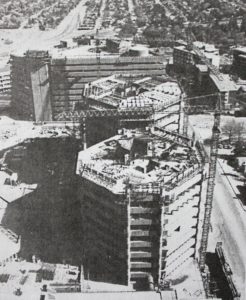Sandton, the name formed from a combination of the names Sandown and Bryanston, is a suburb of Johannesburg, that has about 220,000 people. It is known for its affluence with about 7% of the population being millionaires. Sandton is without a doubt the most important business and financial district in South Africa, and possibly sub-Saharan Africa, a status which has been achieved in less than 30 years.

Sandton was largely a farming and smallholding community when it was promulgated (1969) and has been described as comprising of 30 000 whites and 15 000 horses at the time, by former town planner B Bristow. The first step in transforming Sandton from a farming community to a bustling business district came with the construction of Sandton City, which was developed and constructed by Rapp and Maister and opened for trade in 1974.

The rush of commercial space began in the mid to late 1980’s when land in Sandton, Rosebank and Parktown was cheaper than that in the Johannesburg CBD and could also offer a lifestyle, such as rolling lawns, fountains and low-density, affordable-to-own office space that could not be accommodated in the CBD. Rivonia is the only neighbourhood of Sandton that can claim the distinction of not owing its existence directly to the northward spread of Johannesburg as it was due to its convenience as an outspan stop on the old wagon road to Pretoria, which joined with Johannesburg.
Sandton now represents the second largest office junction in South Africa with the largest junction still being Johannesburg CBD. However, even though the Johannesburg CBD is still the largest, the quality of the office space in Sandton far surpasses that of the CBD and it also commands the highest office rentals in the country.

Sandton has become home to most of the major financial, consulting and banking firms in South Africa with a substantial 7 to 10% of listed companies having postal addresses in Sandton. Certain fundamental changes over the last three years have played a part in solidifying Sandton’s position as the most important business district in the country. These range from new developments to innovation in the green sector making Sandton the epicentre for green building in Africa.
Some of the catalytic changes include the introduction of automated trading on the stock exchange which provided the ability to cut the umbilical cord to the Johannesburg Stock Exchange in the Johannesburg CBD as well as the relocation of and new stock exchange building in Sandton central. And more recently, new developments such as the R3 billion, 5-star, green-star Discovery headquarters and the relocation of the petroleum and oil giant Sasol to their new R2 billion, 67 000 m2 building on Katherine street.

“The new Discovery and Sasol head office buildings are two of the largest green buildings developments in Africa. They are going to be cutting edge marvels of green building and sustainability when they are complete and will add to Sandton’s ever-growing list of landmark green buildings,” says Elaine Jack, City Improvement District Manager of the Sandton Central Management District.
Read more on the developments within the Sandton Central District HERE
We have a number of articles that may interest you, click HERE to read more.


